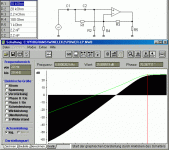and what if I simply put a passive net in the amp input, of course buffering the general input? If I go second order, I won't get more than a Bessel, but I thinK I can live with that.
I've been thinking about the substractive in the Pass paper, trying to get passive also, but didn't get something tangible, any hint?
I've been thinking about the substractive in the Pass paper, trying to get passive also, but didn't get something tangible, any hint?
Konnichiwa,
As also clearly spelled out in the Application note.
Sayonara
Rick NL said:One thing is important with this topology: the feedback resistors shall be low ohmic in comparison to the filter resistors.
As also clearly spelled out in the Application note.
Sayonara
Kuei Yang Wang wrote:
As also clearly spelled out in the Application note.
Kuei Yang Wang,
Yes it is spelled that the impedance around the negative i/p is around 100 Ohms but it is not stated why and what is the consequence when you don't comply to this rule.
It is important as on this forum many contributions state that around 220k/10k or even 470k/15k are sonically best for the gainclone. Not in this topology!
Rick
As also clearly spelled out in the Application note.
Kuei Yang Wang,
Yes it is spelled that the impedance around the negative i/p is around 100 Ohms but it is not stated why and what is the consequence when you don't comply to this rule.
It is important as on this forum many contributions state that around 220k/10k or even 470k/15k are sonically best for the gainclone. Not in this topology!
Rick
Konnichiwa,
Inverting topology, not non-inverting....
Sayonara
Rick NL said:It is important as on this forum many contributions state that around 220k/10k or even 470k/15k are sonically best for the gainclone.
Inverting topology, not non-inverting....
Sayonara
Hi!
Could someone please check out, if this setup would work (and not oscillate)?
Non-Inverting XO with a gain of 22, circuit like in AD's online calculator (link above)..., low pass Bessel 75 Hz (or Butterworth with different values)
C1 2.2 nF
C2 47 nF
R1 1050 K
R2 35.7 K
R3 2.21 K
R4 105 ohm
Non-Inverting XO with a gain of 22, circuit like in AD's online calculator (link above)..., high pass Bessel 75 Hz (or Butterworth with different values)
C1 2.2 nF
C2 2.2 nF
R1 3320 K
R2 243.0 K
R3 2.21 K
R4 105 ohm
I know that inverted design is more stable, but I don't know how to calculate (didn't find a tools for this) the values for inverted design...
Thanks,
Arndt
Could someone please check out, if this setup would work (and not oscillate)?
Non-Inverting XO with a gain of 22, circuit like in AD's online calculator (link above)..., low pass Bessel 75 Hz (or Butterworth with different values)
C1 2.2 nF
C2 47 nF
R1 1050 K
R2 35.7 K
R3 2.21 K
R4 105 ohm
Non-Inverting XO with a gain of 22, circuit like in AD's online calculator (link above)..., high pass Bessel 75 Hz (or Butterworth with different values)
C1 2.2 nF
C2 2.2 nF
R1 3320 K
R2 243.0 K
R3 2.21 K
R4 105 ohm
I know that inverted design is more stable, but I don't know how to calculate (didn't find a tools for this) the values for inverted design...
Thanks,
Arndt
- Status
- This old topic is closed. If you want to reopen this topic, contact a moderator using the "Report Post" button.
- Home
- Amplifiers
- Chip Amps
- How to add a high / lowpass to an IGC / GC?
